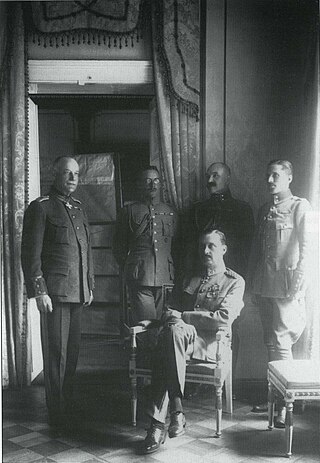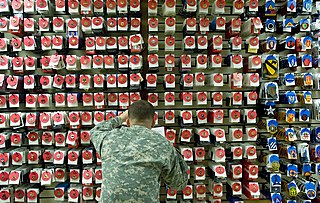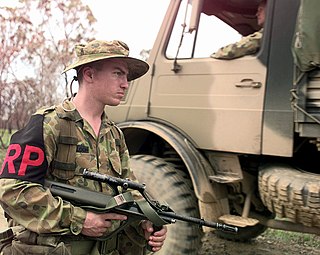This article needs additional citations for verification .(January 2008) |
A provost sergeant is a non-commissioned officer associated with military police.
This article needs additional citations for verification .(January 2008) |
A provost sergeant is a non-commissioned officer associated with military police.
In the British Army and land forces of the Commonwealth, a provost sergeant (sometimes abbreviated to Provo Sgt) is the non-commissioned officer in charge of the regimental provost (or regimental police) and is responsible to the regimental sergeant major for the maintenance of good order and military discipline in a regiment or battalion. [1] Like other members of the regimental police, the provost sergeant is a member of the regiment or corps in which they serve and not a member of the Royal Military Police. A provost sergeant normally holds the military rank of sergeant, the provost sergeant title being an appointment and not a rank. A provost sergeant wears no distinctive trade badge. They can, however, be identified by the brassard they wear on their uniform, which carries the letters "PS"[ citation needed ] or "RP" as well as sergeant's stripes.
In the United States Army Military Police Corps or United States Marine Corps Military Police,[ citation needed ] the title of provost sergeant typically refers to the operations sergeant in charge of the staff of the Provost Marshal office or the NCO in charge of an MP station. The position is commonly held by a sergeant major or master gunnery sergeant, but may also be held by a sergeant first class or master sergeant. U.S. Army provost sergeants cannot be recognized by any specific insignia, and few provost sergeants even wear the distinctive military police identification patch on their Army Combat Uniform.

In military organizations, a colour guard is a detachment of soldiers assigned to the protection of regimental colours and the national flag. This duty is highly prestigious, and the military colour is generally carried by a young officer (ensign), while experienced non-commissioned officers are assigned to the protection of the national flag. These non-commissioned officers, accompanied in several countries by warrant officers, can be ceremonially armed with either sabres or rifles to protect the colour. Colour guards are generally dismounted, but there are also mounted colour guard formations as well.

Military ranks are a system of hierarchical relationships, within armed forces, police, intelligence agencies or other institutions organized along military lines. The military rank system defines dominance, authority, and responsibility in a military hierarchy. It incorporates the principles of exercising power and authority into the military chain of command—the succession of commanders superior to subordinates through which command is exercised. The military chain of command constructs an important component for organized collective action.
Regimental sergeant major (RSM) is an appointment that may be held by a warrant officer (WO) in the British Army, the Royal Marines, and the armies of many other Commonwealth and former Commonwealth nations. It is also an actual rank in the Irish Defence Forces, and formerly in the British Army, Royal Marines and United States Army. Only one warrant officer holds the appointment of RSM in any regiment or battalion, making them the senior warrant officer; in a unit with more than one top-ranked WO, the RSM is considered to be first amongst equals". The RSM is primarily responsible for assisting their commander in maintaining standards and discipline amongst the non-commissioned members and acts as a parental figure to their subordinates, sometimes referred to by the mantra "Drill, Dress and Discipline".
Sergeant is a rank in use by the armed forces of many countries. It is also a police rank in some police services. The alternative spelling, serjeant, is used in The Rifles and other units that draw their heritage from the British light infantry. Its origin is the Latin serviens, 'one who serves', through the Old French term serjant.
Staff sergeant is a rank of non-commissioned officer used in the armed forces of many countries. It is also a police rank in some police services.
Sergeant major is a senior non-commissioned rank or appointment in many militaries around the world.

Adjutant is a military appointment given to an officer who assists the commanding officer with unit administration, mostly the management of human resources in an army unit. The term adjudant is used in French-speaking armed forces as a non-commissioned officer rank similar to a staff sergeant or warrant officer but is not equivalent to the role or appointment of an adjutant.
Master gunnery sergeant (MGySgt) is the 9th and highest enlisted grade in the United States Marine Corps. Master gunnery sergeants are senior staff non-commissioned officers (SNCOs) with the pay grade of E-9, equivalent to sergeants major and the Sergeant Major of the Marine Corps.

A drill instructor is a non-commissioned officer in the armed forces, fire department, or police forces with specific duties that vary by country. Foot drill, military step, and marching are typically taught by drill instructors.

Colour sergeant is a rank of non-commissioned officer found in several armies and marine corps.

A cap badge, also known as head badge or hat badge, is a badge worn on uniform headgear and distinguishes the wearer's nationality and/or organisation. The wearing of cap badges is a convention commonly found among military and police forces, as well as uniformed civilian groups such as the Boy Scouts, civil defence organisations, ambulance services, customs services, fire services etc.

"Other ranks" is the term used to refer to all ranks below officers in the British Army and the Royal Marines. It includes warrant officers, non-commissioned officers ("NCOs") and ordinary soldiers with the rank of private or regimental equivalent. Officers may, in speaking, distinguish themselves from those "in the ranks".

Quartermaster is a military term, the meaning of which depends on the country and service. In land armies, a quartermaster is generally a relatively senior soldier who supervises stores or barracks and distributes supplies and provisions. In many navies, a quartermaster is an officer with particular responsibility for steering and signals. The seaman is a non-commissioned officer rank; in some others, it is not a rank but a role related to navigation.

Mess dress uniform is the most formal type of evening-wear uniform used by military personnel, police personnel, and other uniformed services members. It frequently consists of a mess jacket, trousers, white dress shirt and a black bow tie, along with orders and medals insignia. Design may depend on regiment or service branch, e.g. army, navy, air force, marines, etc. In modern Western dress codes, mess dress uniform is the supplementary alternative equivalent to the civilian black tie for evening wear. Mess dress uniforms are typically less formal than full dress uniform, but more formal than service dress uniform.

A distinctive unit insignia (DUI) is a metallic heraldic badge or device worn by soldiers in the United States Army. The DUI design is derived from the coat of arms authorized for a unit. DUIs may also be called "distinctive insignia" (DI) or, imprecisely, a "crest" or a "unit crest" by soldiers or collectors. The U.S. Army Institute of Heraldry is responsible for the design, development and authorization of all DUIs.
Master warrant officer (MWO) is a senior military rank in the Bangladesh Armed Forces, the Canadian Forces, Singapore Armed Forces, the South African National Defence Force and the Israel Defense Forces.

The uniforms of the British Army currently exist in twelve categories ranging from ceremonial uniforms to combat dress. Uniforms in the British Army are specific to the regiment to which a soldier belongs. Full dress presents the most differentiation between units, and there are fewer regimental distinctions between ceremonial dress, service dress, barrack dress and combat dress, though a level of regimental distinction runs throughout.

Regimental police or regimental provost (RP) are soldiers responsible for regimental discipline enforcement and unit custody in the British Army, other Commonwealth armies and some armed forces structured in the British tradition. They belong to the regiment or corps in which they enforce discipline rather than the Royal Military Police or its equivalent.

A warrant officer (WO) in the British Armed Forces is a member of the highest-ranking group of non-commissioned ranks, holding the King's Warrant, which is signed by the Secretary of State for Defence.

A drum major in the military is the individual leading a military band or a field unit. It is an appointment, not a military rank. Military drum majors utilize a ceremonial mace for giving commands while marching. Many drum majors, particularly American- or British-influenced ones, wear a sash that can carry embroidered badges of their home unit and battle honors; a pair of ceremonial drum sticks are often attached.
Luckily for me the provost sergeant had to return to England and it was decided that I would take his place because being the battalion interpreter I was taken out of the line two days before to find billets for the officers and men. As provost sergeant I was in charge of the battalion police and I had to learn to ride a motorbike which pleased me.